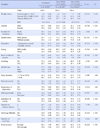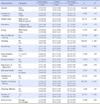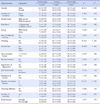Abstract
Purpose
The purpose of the study is to identify differences in BMI between early and late elderly people, and factors having influence of them.
Methods
This study is an analysis of secondary data that used the raw materials from the KNHANES from 2008 to 2010. The subjects involved in the final analysis were 4,772 elders aged 65 or higher. Descriptive statistics, χ2-test and F-test, and CSGLM from the complex sample design were used for the data analysis with SPSS/WIN 19.0.
Results
Significant differences were observed in the socio-demographic characteristics, health behaviors and diet habits between early and late elderly people. Adjusted for gender, location of residence, and living alone, the factors that affected BMI of the early elderly people included current smoking status, number of disease, difficulty in chewing, and number of meals per day while those that affected BMI of the late elderly people were current smoking status, number of disease, self-rated health, and difficulty in chewing.
Figures and Tables
References
1. Bae NK, Kwon I, Cho YC. Ten year change of body mass index in Korean: 1997-2007. Korean J Obes. 2009. 18(1):24–30.
2. Berraho M, Nejjari C, Raherison C, ElAchhab Y, Tachfouti N, Serhier Z, et al. Body mass index, disability, and 13-year mortality in older French adults. J Aging Health. 2010. 22(1):68–83.

3. Chae KH, Won CW, Choi H, Kim BS. Obesity indices and obesity-related quality of life in adults 65 years and older. Korean J Fam Med. 2010. 31(7):540–546.

4. Cho YH. A study on the related factors and status of body mass index in rural elderly. J Korean Gerontol Soc. 2007. 27(4):897–912.
5. Choi H. Evaluation of health status and dietary intakes of the elderly in the rural area by dental health status. 2009. Yongin: Dankook University;Unpublished master's thesis.
6. Choi JH, Kim MH, Cho MS, Lee HS, Kim WY. The nutritional status and dietary pattern by BMI in Korean elderly. Korean J Nutr. 2002. 35(4):480–488.
7. Donini LM, Savina C, Cannella C. Eating habits and appetite control in the elderly: The anorexia of aging. Int Psychogeriatr. 2003. 15(1):73–87.

8. Ferra A, Bibiloni DM, Zapata ME, Pich J, Pons A, Tur JA. Body mass index, life-style, and health status in free living elderly people in menorca island. J Nutr Health Aging. 2012. 16(4):298–305.
10. Kim JS, Kim YH, Yu JO. Factors contributing to low weight in community-dwelling older adults. J Korean Acad Community Health Nurs. 2011. 22(4):429–437.

11. Kim NS, Moon OR, Kang JH, Lee SY, Jeong BG, Lee SJ, et al. Increasing prevalence of obesity related disease for Koreans associated with overweight and obesity. Korean J Prev Med. 2001. 34(4):309–315.
12. Korea Centers for Disease Control and Prevention. The Fourth Korea National Health and Nutrition Examination Survey [KNHANES IV-3]. 2010. Retrieved June 22, 2011. from http://knhanes.cdc.go.kr/.
13. Korean National Statistical Office. Census of elderly population in Korean 2011 year. 2011. Seoul: Author.
14. Krall EA, Hayes C, Garcia R. How dentition status and masticatory function affect nutrient intake. J Am Dent Assoc. 1998. 129(9):1261–1269.

15. Lee MS. Nutritional risk, perceived health status, and depression of the young-old and the old-old in low-income elderly women. J Agric Med Community Health. 2012. 37(1):12–22.

16. Lee IS, Ko Y, Lee KO. Evaluation of the effects of a frailty preventing multi-factorial program concentrated on local communities for high-risk younger and older elderly people. J Korean Acad Community Health Nurs. 2012. 23(2):201–211.

17. Lee JH. Effect of body weight on mental health in the elderly. J Korean Geriatr Psychiatry. 2004. 8(2):102–106.
18. Lee KS, Hwang IC, Kim SS, Kim KK. Perception of obesity and its related factors. Korean J Obes. 2009. 18(3):116–122.
19. Lee S, Jeon S, Lee J. Factors related with low body weight in older adults at a urban-rural composite area. J Korean Gerontol Soc. 2008. 28(1):105–121.
20. Oh Y, Bae W, Kim O. A study on physical and mental function affecting self-perceived health of older persons in Korea. J Korean Gerontol Soc. 2006. 26(3):461–476.
21. Ritchie CS, Joshipura K, Silliman RA, Miller B. Oral health problems and significant weight loss among community-dwelling older adults. J Gerontol A Biol Sci Med Sci. 2000. 55(7):M366–M371.

22. Statistics Korea. 2010 elderly statistics. 2010. Retrieved Oct. 28, 2011. from http://kostat.go.kr.
23. Statistics Korea. 2011 elderly statistics. 2011. Retrieved Feb. 20, 2013. from http://kostat.go.kr.
24. Woo J, Leung J, Kwok T. BMI, body composition, and physical functioning in older adults. Obesity. 2007. 15(7):1886–1894.

25. Yan LL, Daviglus ML, Liu K, Pirzada A, Garside DB, Schiffer L, et al. BMI and health-related quality of life in adults 65 years and older. Obes Res. 2004. 12(1):69–76.

26. Yeom J, Kim JK, Crimmins EM. Factors associated with body mass index (BMI) among older adults: A comparison study of the U.S., Japan, and Korea. J Korean Gerontol Soc. 2009. 29(4):1477–1498.
27. Yim KS, Lee TY. Sociodemographic factors associated with nutrients intake of elderly in Korea. Korean J Nutr. 2004. 37(3):210–222.
28. Yoo J, Yoo K. The influence of smoking and smoking cessation on body weight and exercise abilities. J Coaching Dev. 2006. 8(4):185–194.




 PDF
PDF ePub
ePub Citation
Citation Print
Print






 XML Download
XML Download